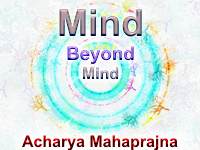
.
If one does not know how to swim, he needs a boat to cross the river. If he wanted to cross the river of life, he would need a special kind of boat. Bhavana is such a boat. One can use it at any time he likes; it is capable of carrying him to any destination he likes to go to.
Bhavana means repeating an idea or thought time and again. According to Patanjali, meditation has three forms: Dharana (idea or image formation), Dhyana (contemplation) and Samadhi (ecstasy). According to the Jain discipline, they are: Bhavana, Dhyana and Samadhi, Dharana and Bhavana are one and the same thing. Bhavana may be defined as concentration of the mind on some subject, mental or objective. It is the first stage, Dhyana is the second and Samadhi the third. Bhavana, contemplation on some object and Japa (chanting of a Mantra) belong to the same category. The difference in the terms has been dictated by practical necessities. Japa means concentration on the image of some person or object and absorption in it. Bhavana, Savisaya Dhyana and Dharana are identical states of the mind.
Bhagavana Mahavira said that the soul, which has become pure through Bhavana Yoga, is like a boat capable of reaching the shore of the sea of life at any time. The only question is how to use it. It is essential to be seized of the idea or image to be contemplated on and a complete absorption in it. The Agamas (Jain scriptures) speak of a class of monks called Bhavitatmas (completely absorbed). This absorption enables the practitioner to enter into any state of mind he likes. The human mind is capable of assuming any form or state. Bhavana is an implement of bringing about a transplantation of the mind into any state. Mental changes bring about changes in the body also.
An American youth happened to come in contact with a French girl. Both fell in love with each other. When the question of marriage came up, the young man said that he would marry her only after he had begun to earn. The girl agreed. The young man returned to the States in search of a job. It took a few years for him to earn a little fortune. During his absence the girl began to have doubts. She thought that, with the passage of time, she might lose her charm and the boy, when he returned, may not like her any more. She, therefore, devised a means of keeping her youth and attractiveness intact. She would stand before a mirror and feel that she was still young and charming. She continued this practice for years and years together. Eventually the young man returned. He too had been assailed by uncertainties and doubts about his beloved. She might have changed physically and lost much of her former charm, he thought. But when he met her, he was pleasantly surprised to find her as charming and young as she had been when he left her. The girl had practised Bhavana and that was the secret of her maintaining her youth and charm.
There are thousands of the applications of Bhavana and the Jain tradition has immensely valued Bhavana Yoga. Take, for example the game of bull fighting. The man who fights the bull applies the force of Bhavana in meeting the infuriated animal. He develops the proper mood, comes in form to fight the bull, and feels himself superior to it. The terrible charge of the animal is rendered ineffective by the sheer force of Bhavana on the part of the man.
Bhavana is also capable of producing material effects. These effects comprise of removing the difficulties of others, curing diseases, bringing about a change of heart in others, and affecting them mentally. It does bring about changes in the practitioner. It can cure physical and mental deformities. It can be applied to innumerable situations. Autosuggestion is a kind of Bhavana and is immensely useful in curing diseases by a sheer mental exertion of the patient.
Let us now examine the role played by Bhavana in Sadhana. The Jain tradition lays great stress on Bhavana as an implement of Sadhana, much more than other traditions. According to the Jain classification, there are four kinds of Bhavana:
| 1. | Jnana Bhavana |
| 2. | Caritra Bhavana |
| 3. | Tapa Bhavana |
| 4. | Vairagya Bhavana |
The practitioner of Bhavana Yoga must first master Jnana Bhavana. He must consolidate his thought processes and must put a stop to their succession. The succession of thoughts may also be helpful in the earlier stages. Some times the repetition of a particular thought produces its corresponding mood or Bhavana. We are influenced by deeds as well as thoughts. When we concentrate on ideas or thoughts, they begin to seize us. They become a second nature in us, so to say.
How should then we bring about changes in ourselves through Bhavana? The first step is to choose an objective or what we propose to do or become. One may choose to be a poet or a philosopher. He may like to be a writer or a scholar. The next step is to enter into the proper mood for the achievement of the objective. For this purpose, he should retire into a solitary place and sit with his body completely immobilized. He should also relax his mind. There should be no physical or mental tension in him. The purpose of the practice at this stage is to push the object from the conscious to the subconscious part of his mind. Bhavana means the predominance of the subconscious as against the conscious part of the mind. The object, when it is transferred from the conscious to the subconscious part becomes embedded therein. A completely relaxed mind and body are essential to this transplantation of the object. The subconscious mind becomes activated. The next step is to repeat the word symbolizing the object of meditation, first with a medium pitch of the voice and then with a louder pitch. This should be done for at least ten minutes. Doing this for a shorter period of time will not do. This should be done every day. There should not be any break in the practice. The practitioner should also try to behave like the object. Sooner or later, he will achieve his aim. No body can be religious and reach the higher planes of meditation except through Bhavana, which is the precondition of physical, mental, and intellectual development.
We have to employ several means for the achievement of our ideas. For this purpose we have to be very careful in removing from our minds every kind of delusion. We will have to discard everything which produces delusion. Bhavana means identification with the ideal.
 Acharya Mahaprajna
Acharya Mahaprajna

